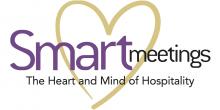The silver lining of Covid may have been that all those virtual events delivered content to attendees who previously may not have been able to attend in-person events. Now that everyone is rushing back to the ballroom, Smart Meetings magazine is examining best practices for producing events that make everyone feel welcome. We recently talked to Keely Cat-Wells, founder and president of C-Talent, to create an inclusive list that proactively removes barriers to attendance. Cat-Wells should know. She once arrived to speak at an event about the importance of diversity and accessibility with her colleague, who was in a wheelchair, and the two were met with a startling realization. The room that was booked for the event was entirely inaccessible. The event space was up three flights of stairs and had no available elevator. There was also no video captioning and no sign language interpreter.
Organizers eventually moved the event to a coffee house across the street. The experience was disappointing, but after the event, Cat-Wells remained in contact with event organizers, and after some discussion, they were open to putting accessibility on their list of to-dos for future events.
Here are some more simple items to add to the list that could sideswipe similar event fails in the future.
1. Include Disability in the Diversity Conversation
“Disability is chronically left out of diversity conversations,” Cat-Wells said. In 1990, the disability community won a major victory against discrimination with the passing of the Americans with Disabilities Act (ADA). But Cat-Wells believes the industry can do much more than the baseline. “Access is so much more than that basic compliance. We have to go beyond compliance,” she said.
2. Budget for Accessibility from the Beginning
From the inception of the event, access has to be included as a line item on the marketing and production budget. Cat-Wells shared that accessibility typically gets the short end of the stick during budget prep when meeting professionals try to cut corners by using AI-generated captions, for instance, that are not as accurate as human transcriptions. “Cutting costs won’t pay off in the long run,” said Cat-Wells. “People have to take this seriously now.”
3. Be Open to Change
One free adjustment is to be open to dialog and ideas around how to improve.
“It is an education process. Accessibility is a journey, and it’s new to many people, but when you are met with resistance when you do educate, that’s the most frustrating thing,” Cat-Wells said.
4. Put Disability Advocates in Leadership Positions
One big factor that could improve awareness of accessibility at events is placing those with disabilities and disabilities advocates in leadership positions.
“A lot of people are just so scared to talk about disability,” Cat-Wells offered. Giving representation to those who understand the importance of accommodation is the best way to practice diversity and disability with integrity.
5. Universal Design Is Good for Everyone
The benefits of creating accessible spaces go beyond access for the disabled. Cat-Wells pointed out that accessibility helps everyone because it preserves humanity.
“All opinions and people’s life experiences are valuable and will benefit the event. Universal design is going to make your event smoother, more efficient and better for everyone. It’s not just a disability issue—it’s an everybody issue.” Read more about easy ways to welcome everyone on Smartmeetings.com.





